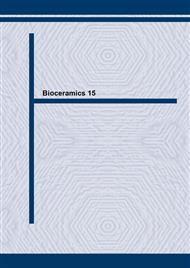[1]
J. B. Park and R. S. Lakes: Biomaterials; An Introduction Second Edition (Plenum Press, New York 1992), p.194.
Google Scholar
[2]
M. Tanahashi, T. Yao, T. Kokubo, M. Minoda, T. Nakamura and T. Yamamuro: J. Am. Ceram. Soc. 77 11 (1994), p.2805
Google Scholar
[3]
P. Li, C. Ohtsuki, T. Kokubo, K. Nakanishi, N. Soga and K. de Groot: J. Biomed. Mater. Res. Vol. 28 1 (1994), p.7.
Google Scholar
[4]
M. Tanahashi and T. Matsuda: J. Biomed. Mater. Res.Vol. 34 3 (1997), p.305.
Google Scholar
[5]
S. Konagaya and M. Tokai: J. Appl. Polym. Sci. 76 6 (2000), p.913.
Google Scholar
[6]
T. Kokubo, H.-M. Kim, M. Kawashita, H. Takadama, T. Miyazaki, M. Uchida and T. Nakamura: Glastech, Ber, Sci. Technol. 73C1 SC1 (2000), p.247. 20 25 30 35 Intensity / Arb. unit 2 / degree 7 days 3 days 1 day Before soaking θ 20 25 30 35 Intensity / Arb. unit 2 / degree 7 days 3 days 1 day Before soaking ٤ ٤ ٤ ٤ ٤ Apatite θ Fig. 3. TF-XRD patterns of the surfaces of S(0) and S(50) films before and after soaking in 1.5SBF for various periods. S(0) S(50)
DOI: 10.7717/peerj.6518/supp-2
Google Scholar


